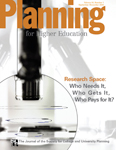- Integrated Planning
Integrated Planning
Integrated planning is a sustainable approach to planning that builds relationships, aligns the organization, and emphasizes preparedness for change.
- Topics
Topics
- Resources
Resources
Featured Formats
Popular Topics
- Events & Programs
Events & Programs
Upcoming Events
- Building Buy-in for Planning: Dealing With Resistance and Gaining Support
Online | March 11 – April 8 - Budgeting for Impact: A Working Group on Resource Planning in Higher Education
Online | Feb 5, Feb 19, March 5 - Cross-Functional Collaboration: Tools and Skills for Working Across Silos
Online | February 10, 17, 24
- Building Buy-in for Planning: Dealing With Resistance and Gaining Support
- Community
Community
The SCUP community opens a whole world of integrated planning resources, connections, and expertise.
- Integrated Planning
Integrated Planning
Integrated planning is a sustainable approach to planning that builds relationships, aligns the organization, and emphasizes preparedness for change.
- Topics
Topics
- Resources
Resources
Featured Formats
Popular Topics
- Events & Programs
Events & Programs
Upcoming Events
- Building Buy-in for Planning: Dealing With Resistance and Gaining Support
Online | March 11 – April 8 - Budgeting for Impact: A Working Group on Resource Planning in Higher Education
Online | Feb 5, Feb 19, March 5 - Cross-Functional Collaboration: Tools and Skills for Working Across Silos
Online | February 10, 17, 24
- Building Buy-in for Planning: Dealing With Resistance and Gaining Support
- Community
Community
The SCUP community opens a whole world of integrated planning resources, connections, and expertise.
 Planning for Higher Education Journal
Planning for Higher Education JournalUsing Scenarios and Simulations to Plan Colleges
 From Volume 33 Number 1 | September–November 2004By Chuck McIntyrePlanning Types: Strategic Planning
From Volume 33 Number 1 | September–November 2004By Chuck McIntyrePlanning Types: Strategic Planning
Institutions referenced in this resource:
College of the DesertUsing a case study, this article describes a method by which higher education institutions construct and use multiple future scenarios and simulations to plan strategically: to create visions of their futures, chart broad directions (mission and goals), and select learning and delivery strategies so as to achieve those broad directions. The four scenarios described in this article are written by combining two assumed “external” sets of future trends and conditions with two “internal” sets of institutional policies. Simulation of future college enrollment under each scenario enables planners not only to mitigate uncertainty and explore implications of different numbers of students but also to analyze the characteristics of these students to design educational content and delivery that is learning centered and, therefore, likely to be effective. The simulations also frame fiscal issues for a broad range of future conditions, thereby alerting planners to long-range strategies and options such as distance learning, partnering, and differential pricing, among others, that might not otherwise have been pursued.
MEMBERS ONLY
Attention Members: Log in to access this item.Not a member? Join now to access this article and all journal articles for free. - Topics
- Topics


